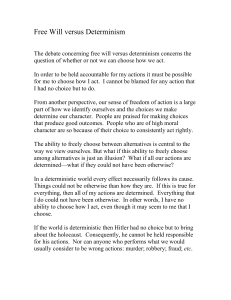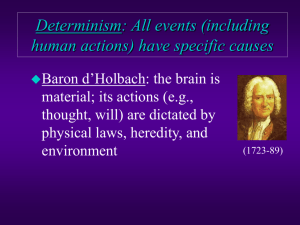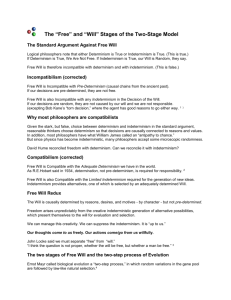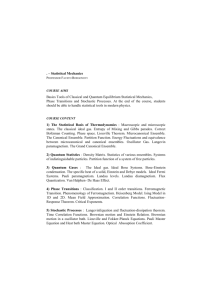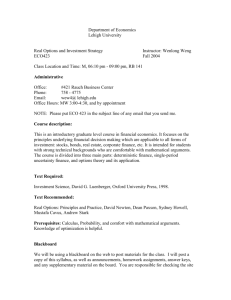Patrick Suppes Probabilistic Metaphysics, have argued at
advertisement
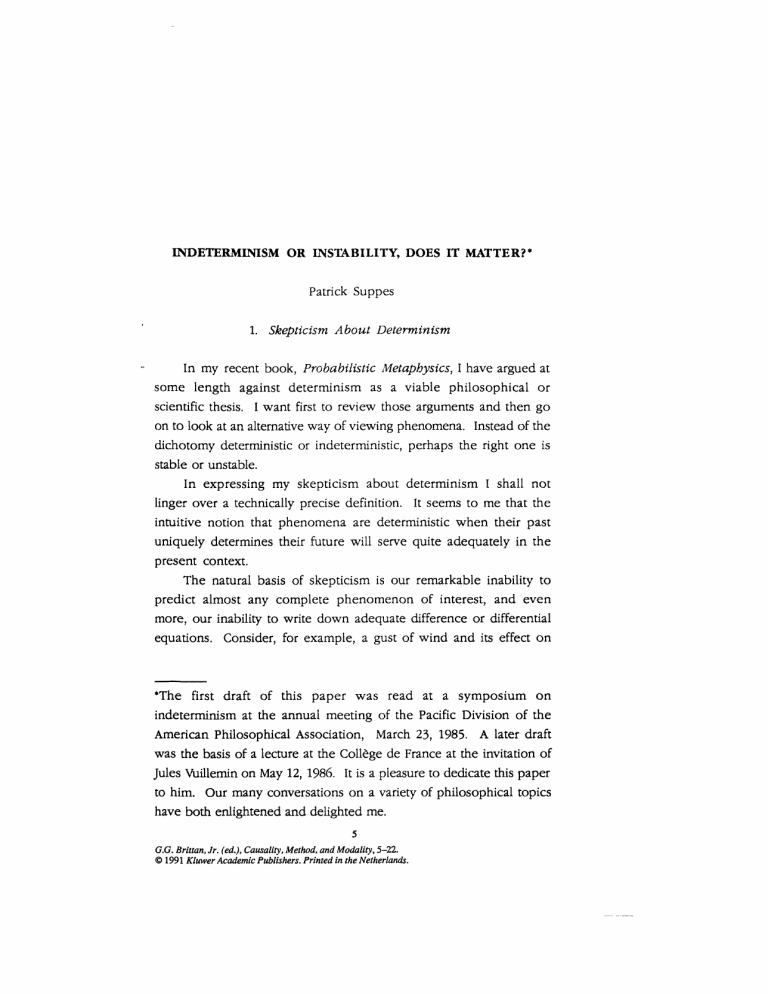
INDETERMINISM OR, INSTABILITY, DOES IT MATTER?* Patrick Suppes 1. Skepticism AboutDeterminism In my recent book, Probabilistic Metaphysics, I have argued at some length against determinism as a viablephilosophical or scientific thesis. I want first to review those arguments and then go on to look at an alternative wayof viewing phenomena. Instead of the dichotomy deterministic or indeterministic, perhaps the right one is stable or unstable. Inexpressing my skepticismaboutdeterminism I shall not linger over a technically precise definition. It seems to me that the intuitive notion that phenomena are deterministic when their past uniquely determines their future will serve quite adequately in the present context. The natural basis of skepticism is our remarkable inability to predict almost anycompletephenomenon of interest, andeven more, our inability to write down adequate difference or differential equations. Consider, for example, a gust of wind and its effect on readat a symposium o n *The first draft of this paperwas indeterminism at the annual meeting of the Pacific Division of the American Philosophical Association, March 23, 1985. A later draft was the basis of a lecture at the Collège de France at the invitation of Jules Vuillemin on May 12>1986. It is a pleasure to dedicate this paper to him. Our many conversations on a variety of philosophical topics have both enlightened and delighted me. 5 G.G. Brittan, Jr. (ed,),Causality, Method,and Modality, 5-22. O 1991 Kluwer Academic Publishers. Printed in the Netherlands. 6 PATRICK SUPPES leaves of grass, the branches of a tree, the partlcles of dust agitated in various ways. It seems utterly out of the question to predict these effects in any detail. Moreover, it seems hopeless even to think of writing down the equations, let alone solving them. It might be noted of the the particles of dust,at least, wouldbe withintherange phenomena of Brownian motion, and the hopelessness of actually predicting such motionhasbeenrecognized for a long time. Of course, this example of Brownian motion raises a problem that needs remarking. One standard view of classicalphysics is that all phenomena are deterministic,--it is just that w e are unable to analyze some phenomena in adequate detail. But even here there is reason of the standardtheory of forskepticism.Thestandardresult Brownian motion is that because of the high incidence of collisions the path of a particle is contmuous but differentiable almost nowhere (only on a set of measure zero). Given that the path is this kind of trajectory, it becomes obvious that determinism is out of the question just because of the many collisions. It is a familiar fact of classical mechanicsthat collisionsin generalcausegreat difficultyfor deterministic theorems. The kind of result that we have in the case of Brownian motion is not just a matter of difficulty, it is a matter of principled hopelessness. So I take it that insofar as the phenomena I have just described fall within the purview of the theory of Brownian motion, determinism is ruled out. For many familiar human phenomena we do not even have the elements of schematic analysis given by the probabilistic theory of Brownian motion. Examples are easy to think of. A favorite of mine is the babble of speech. The idea of ever being able to determine the flow of talk even between just one set of persons, not to speak of a billion, given whatever knowledge you might hope to have seems ridiculous and absurd. There is no reason whatsoever to think we will ever have theories that lead to deterministic results. It is certainly true that inoccasional high states of deliberation w e formulatevery INDETERMINISM OR INSTABILITY 7 carehlly the words we are going to utter, but this is not the standard of high condition of speech. Moreover, even in suchstates deliberation we do not and are not able consciously to control the prosodic contours of the utterance. In fact, as we descend from the abstract talk of grammarians and modeltheorists concerned with semantics to the intricate details of the actual sound-pressure waves emitted by speakers and received by listeners, the problem of having a deterministic theory of speech looms ever more hopeless. I havethesameskepticismtowarddeterministictheories of vision. Suck a theory for any serious level of detail seems out of the question. The reasons for thinking this aremany in number.The long history of theories of vision and the difficulties we still have in giving detailed partial descriptions of what the visual system is sensing provide some evidence. Detailed physiological studies showing that the human eye is sensitive to even a single photon provide other kinds of evidence,as d o quantitativestudies of eyeandhead movements. The extraordinarily complicated nature of the transduction that takes place in the optical system in order to send messages to the centralnervous systems is another case inpoint. wecouldhave a gross Someone might want to claimthat deterministic theory of vision, but such a theory would be superficial and uninteresting. The actual mechanisms seem intrinsically subtle and complex. Of course, there are some kinds of complex problems that we feel confident in tackling, but anyone who has taken a serious of vision will back awayratherrapidlyfrom lookatproblems of optimistic claims about having within the framework contemporary science, or science as we can foresee it to be in the future, a workable, detailed deterministic theory. What I have had to say about speech and vision applies also to the sense of smell. The evidence seems pretty good that this sense is sensitive down to the presence of a substance at the molecular level. Moreover, whattheoriesthereare of the activities of single 8 PATRICK SUPPES recognition cells are probabilistic in character. As far as I know, no one hasattempted to propose a serious deterministic theory of smell. These familiar phenomena I am using to buttress my reasons for skepticism about determinism are easily matched by a dozen others. Given the extraordinarily small number of phenomena about which we can have a deterministic theory, there is cause for psychological and philosophical speculation as to why the concept of determinism has ever achieved the importance it has in our thinking about the world around us. To adopt a broad deterministic view toward the world does require not quite the extreme faith of the early Christians, but at least that of such diverse eighteenth-century optimists as Kant and Laplace*. Surely one psychological root of the faith in determinism is its conflationwithprediction. Hegel (1899, p. 278) reportsthat Napoleonin a conversationwithGoetheremarkedthatthe conceptual role of fate in the ancient world has been replaced by that of bureaucratic policy in modern times withthe implication that of individualbehaviorsubject to the uniformpredictability bureaucracy is, in principle, what we can now have. The search for methods of prediction has ranged from zodiacs to chicken gizzards and is found in every land. The primitive urge to know the íüture has in no way been stilled by modern science, but only rechanneled into more austere forms. The new skepticism so I am arguing, should be abouttheomnipresence of determinism,nottheomniscience of God. *Historically we probablyneed determinist. to think of Kant as a crypto- INDETERMINISM OR INSTABILITY 9 2, How toSaveDeterminism Before making some direct comparisons with indeterminism in terms of instability there are some preliminary points to be made about unstable systems. The intuitive idea of instability in mechanics is this. Wide divergence i,n the behavior of two systems identical except for initial conditions is observedevenwhenthe initial conditions are extremely close. There are two aspects of unstable of theirbehavior difficult, and systems thatmakeprediction therefore make difficult the realization of the deterministic program, even if the systems are, in fact, deterministic. One source of difficulty is that the initial conditions can be measured only approximately. If a system is notstable in theappropriate sense--1 omit a technical definition here but it is straightforward to give one--, it will be impossible to predict its behavior for any but short intervals of time with any accuracy. In this case, we attributed predictive failures to a possibly small uncertainty in the initial conditions. We shall leave aside in the present discussion whether this uncertainty should be treated epistemologically or ontologically. Some later remarks will have something more to say about this issue. A second aspect of an unstable system can be that the solutions are not givenin closed form, and calculations based on various methods of series expansion, etc., will not give accurate predictions. In other words, we cannot count on numerical methods to give us a detailed result for periods of prediction of any length. If the system is unstable, the accumulation of small errors in numerical methods of approximation, which may be the only ones available, can lead to unavoidable problems of accuracy. Thislast problem is especially true of systems that are governed by nonlinear differential equations. What I have said thus far applies to very simple systems of differential equations as well as complex ones. The solutions of the equations may be unstable but they do not seem to exhibit the kind PATRICK SUPPES 10 of behavior we so directlyassociatewithindeterministic or probabilistic behavior. It might be argued that the simplest systems of linear differential equations that are unstable do not represent something comparable to indeterminism. Yet it is true that for such unstablelinear systems the accuracy of predictions will be poor, given, as is always thecase in real situations, anyerrors in the words, unstable measurement of initial conditions. In other of deterministiclinearsystemscapture an importantaspect indeterminism, namely, our inability to predict future behavior on the basis of knowledge of present behavior. There is another aspect also of suchlinear systems that needs to benoted. In most applications, the linearity of the real system that is being modeled by the linear differential equations is only approximate. Almost always, deviations from linearity in the real system--the fact that the linear differential equations are only approximations--!, will make our ability to predict actual phenomena even more limited. 3. Chaos and Symbolic Dynamics We now get down to essentials. Those special unstable solutions of differential equations that exhibit chaotic behavior provide the intendedalternative to indeterminism. It wouldhave been more accurateincertain ways to entitle this paper‘Indeterminism or Chaos, Does it Matter?’, but the meaning of chaos is too special, and so it is the central concept of instability that should be kept to the fore. So, what dowe mean by chaos? A brief butnotquite technicallycorrectdefinition is the following. A solution of a deterministic system of differential equations is chaotic if and only if it exhibits some aspect of randomness--or, as an alternative, sufficient complexity. To some, this definitionwouldseem to embody a contradiction, and therefore no solutions would satisfy it. On the left- OR INDETERMINISM 11 hand side we refer to a deterministic system of equations and on the right-hand side to the random character ofits solution. How can a deterministic system have a random solution? This is what chaos is all about, and the discovery of the new phenomena of chaos is certainly a watershed change in the history of determinism. Before turning to the recent discussions of chaos, itwill be useful to go back over the earlier history of developing the theory of random processes within classical mechanics. The origin of the approach, usually called themethod of arbitrary functions for a reason to be explained in a moment, originates with Poincaré, but has been developed in detail by a number of mathematicians in the first half of this century. Already a rather short qualitative sketch of the ideas in very accessible form is given by Poincaré in Science and Hypothesis (1913). (The history of developments since Poincaré has been chronicled in some detail by von Plato (1983).) Here I shall just give a sketch of the analysis of coin flipping, one of the most natural cases to consider. To a large extent I shall follow the recent treatment due to Keller (1986), but as somewhat modified in Suppes (1987). Without going into details, we shall assume a circular coin that is symmetric in all the ways you would imagine; second, dissipating forces of friction are entirely neglected; third, it is assumed that the coin does not bounce but on its initial point of impact flattens out to a horizontal position. In other words, from the initial point of impact the face up does not change. With this idealized model, the physical analysis is simple. Newton’s ordinary law of gravity governs the vertical motion of the particle--we assume there is no horizontal motion. Second, we assume that the rotational motion is that of constant angular velocity SQ there is no angular acceleration to the rotation. Now with this situation, if we knewthe exact initial conditions, we could predict exactly how the coin would land, with either heads or tails face up. In fact, the classical analysis of this case assumes rightly enough that we do not know the exact value of the 12 PATRICK SUPPES initial conditions. The method of arbitrary functions refers to the fact that we assume an arbitray probability distribution of initial vertical velocity and initial rotational velocity. Then as the initial velocity tends to infinity, whateverthe arbitrary distribution we beginwith, the probability of a head will be one-half. In other words, the symmetry in the mechanical behavior of the system dominates completely as we approach the asymptotic solution. Of course, in real coin-flipping situations we are not imparting an arbitrarily large vertical velocity to the coin, but the variation in the way that we flip will lead to a very goodapproximation to one-half. The point is that in this typical of analysis, therandomnessentersonlythroughtheabsence knowledge of initial conditions. It is an important example of randomness in mechanical systems, one that has only recently begun to be recognized again as an important example, but it is not the kind of example on which I want to concentrate here. To showthattheconventionalphilosophicaldichotomy between determinism and randomness is mistaken, I consider two important and much discussed examples. The first is a special case of the three-body problem, certainly the most extensively studied problem in the history of mechanics. Our special case is this. There are two particles of equal mass moving according to Newton’s inverse-square law of gravitation in an elliptic orbit relative to their common center of mass which is at rest. The third particle has B nearly negligible mass, so it does not affect the motion of the other two particles, but they affect its motion. This third particle is moving along a line perpendicular to the plane of motion of the first two particles and intersecting the plane at the center of their mass. From symmetry considerations, we can see that the third particle will not move off the line. The restricted problem is to describe the motion of the third particle. The analysis of this easily described situation is quite complicated and technical, but some of the results are simpletostate in informalterms and directly INDETERMINISM OR INSTABILITY 13 relevant to my focus on determinism and randomness. Near the escape velocity for the third particle--the velocity at which ít leaves is very anddoesnot periodicallyreturn, theperiodicmotion be irregular. In particular, thefollowingremarkabletheoremcan proved. Let t t2,.. be the times at which the particle intersects the plane of motion of theother two particles. Let Sk be the largest integer equal to or less than the difference between tk+l and tk times a fixed constant*. Variation in the s i s obviouslymeasuresthe irregularity in the periodic motion. The theorem, due to the Russian mathematicians Sitnikov (1960) and Alekseev (1968a,b; 1969a,b), in the version given by Moser (1975) is this. o * THEOREM. Given that the eccentricity of the ellipticorbit is positive but lzot too large, there exists an integel: say d such that any infinite sequence of terns Sk with sk I d corresponds to a solution of the deterministic dqferential equation governing the motion of the third particle**. A corollary about random sequences immediately follows. Eet s be any random sequence of heads and tails--for this purpose we can Kolmogorov, use any of the severalvariantdefinitions--Church, Martin-Löf, etc.. We pick two integers greater than d to represent the random sequence--the lesser of the two representing heads, say, and the other tails. We then have: *The constant is the reciprocal of the period of the motion of the two particles in the piane. **The correspondence between a solution of the differential equation and a sequence of integers is thesource of thetermsymbolic dynamics. The idea of such a correspondence originated with G.D. Birkhoff in the 1930's. PATRICK SUPPES 14 Corollary. Any random sequence of heads and tails corresponds to a solution of the deterministic differential equation governing the motion of the third particle. In other words, for each random sequence there exists a set of initial conditions that determines the corresponding solution. Notice that in essentialways the motion of the particle is completely unpredictableeventhough deterministic. Thisis a consequence at once of theassociated sequence beingrandom. It is important to noticethedifferencefromtheearliercoinflippingcase,for no distributionover initial conditions and thus no uncertainty about them is present in this tree-bodyproblem. No single trajectory in the coin-flipping case exhibits in itself such random behavior. This exampledemonstratesthestartling fact that thesame phenomena can be both deterministic and random. The underlying explanation is theextraordinaryinstability of thedeterministic phenomena. Before remarking further on the significance of this result, I turn to the second example which is an abstract discrete model of period doubling. Because the mathematics is more manageable it is a simple example of a type much studied now in the theory of chaos. The example also illustrates how a really simple case can still go a long way toward illustrating the basic ideas. Let f be the doubling hnction mapping the unit interval into itself. f(xn) kn(mod 11, where mod 1 means taking away the integer part so that lies in the unit interval. So if x1 = 2/3, x2 = 1/3, x3 = 2/3, x4 = 1/3 and so on periodically. The explicit solution of equation (1) is immediate: (1) %+l (2) xn+l+ 2"xl(rnod 1). With random sequences in mind, let us represent x1 in binary decimal notation, i.e., as a sequence of l's and O's. Equation (1) now can be expressed as the rule: for each iteration from n to n + l move the decimal point one position to the right, and drop whatever is to INDETERMINISM OR INSTABILITY 15 the left of the decimal point: .loll...+ .Oll... . We think of each x, as a point in the discrete trajectory of this apparently simple system. The remarks just made show immediately that the distance between successive discrete points of the trajectory cannot be predicted in general without complete knowledge of xl. If x1 is a random number, i.e., a number between O and 1 whose binary decimal expansion is a random sequence, then such prediction will be out of the questionunless x1 is known. Moreover, anyerrorin knowing x1 spreads exponentially--the doubling system defined by equation (1) is highly unstable. Finally, it is a well-known result that almost all numbers are random numbers in the sense defined. Although the exact technical details are rather complicated for almost all chaoticsystems,the first example of a restricted threebody problem was meant to illustrate orbitalcomplexity and the second complexity of initial conditions. In any case, randomness can be an essential part of the behavior of what would seem to be quite simple deterministic systems. 4. The Troublesome Case of Quantum Mechanics. From what I have just said, the elements of a rejoinder to my earlier skepticism about determinism are apparent. The phenomena cited as examples of indeterminism are in fact just examples of highly complex,unstabledeterministicsystemswhosefuturebehavior cannot be predicted. The strongest argument against such view comes from quantum mechanics. Beginning in the 1930’s there has been a series of proofs that deterministic theories are in principle inconsistent with quantum mechanics. The first proof of the impossibility of deterministic hidden variables was by von Neumann. The latest arguments have centered on the inequalities first formulated in 1964 by John Beil. 116 PATRICK SUPPES Moreover, the associatedexperimentsthathave been performed havealmostuniformlyfavored quantum mechanicsoverany deterministic theory satisfying the Bell inequalities.Tothose who accept the standard formulation of quantum mechanics, the various proofs about the nonexistence of hidden variables answer decisively the question in the title of this lecture. Indeterminism or instability, does it matter? For these folk the answer is affirmative. The negative results show chaoticunstabledeterministicmechanicalsystems to beconsistentwithstandardquantum cannotbeconstructed mechanics. The conclusion of this line of argument is that standard of an quantummechanics is the most outstandingexample intrinsically indeterministic theory. There is, however, a still live option for those of us who are not entirely happy with the orthodox theory of quantum mechanics and its manypeculiarfeatures.Theoption left open is to account for quantumphenomena in terms of something like thetheory of Brownian motion, which is, of course, part of classical mechanics far the broadlyconstrued. Nelson (1967, 1985) hasprovidedthus best defense of this approach. He has,forexample,derived the Schroedinger equation, the most important equation of nonrelativistic quantum mechanics, from the assumptions of Newtonian mechanics. However, his recent analysis (1985) ends up with Bell’s theorem and therelevantexperimentsasaseriousproblem.The most feasible to betodevelop anon-Markovianstochastic wayoutseems mechanics,whichin itself representsadeparturefrom classical nonlocality. The central problems of current physics are not much concerned with this alternative, but mathematicians and philosophers will continue to puzzle over the foundations of this century’s most successful scientific theory. As long as the stochasticview ir! the the question sense of Brownianmotion remains aviableoption, not”. posed in the title can be answered byaskeptical“Perhaps Consistent with this view, Laplace’s concept of probability and thus INDETERMINISM OR INSTABILITY 17 of indeterminismalso remains a viable option--probability is the expression of ignorance of deterministic causes. 5. Randomness as a Limiting Case of Unstable Detemzinism The existence of deep-seated randomness inside deterministic systems can be attributed to their great instability, and this suggests the road of rapprochement between determinism and randomness. A strikingfeature of randomness and instability is complexity. in terms of Moreover, recent definitions of randomnessare complexity. The complexity of a sequence of finite symbols is measured by the length of a minimal computer program that will generatethesequence. (For asymptotic purposes,the particular computerorcomputerlanguagedoesnot matter.) A simple alternating sequence of l’s and O’s can be generated by a very short program. More intricate sequences require longer programs and are therefore more complex. Where this argument is going should be apparent. Random sequences are of maximal complexity. In fact, the programs required to generate them would have to be infinitely long. So whatarerandom sequences?They arethe limiting case of increasingly complex deterministic sequences. Randomness is just a feature of the most complex deterministic systems. And what of particular importance follows from this? The separation of determinism and predictability. The most complex deterministic systems are completelyunpredictable in their behavior. Laplace’s “higher intelligence’’ must be transfinite. He must beable to do arbitrarily complex computations arbitrarily fast. To give a modern ring to Laplace’s basic idea, I propose this. Randomness is the expression of maximal& complex deterministic causes. PATRICK SUPPES 18 6. Does It Mutter? Setting aside, for the moment, the problem of hidden variables in quantum mechanics, we may argue that the philosophically most interesting conclusion to be drawn from the analysis outlined in this paper is that we cannot distinguish betweendeterminism and indeterminism. The true-blue determinist can hold, without fear of contradiction, that all processes aredetermined. Confronted with the myriad examples of natural phenomena that cannot be predicted and that seem hopeless to try to predict, he can reply with serenity that eventheseprocessesare deterministic,butthey arealso unstable. The determinist can agree amiably enough that there are processes yet to be analyzed and that his belief that they too will turn out to be deterministic is only based on past experience. Thislast are natural remark is meant to ring a Bayesian bell. Pure Bayesians true-blue determinists. Afterall, de Finetti begins his two-volume treatise on probability by printing in capital letters: PROBABILITY DOES NOT EXIST, a thesis Laplace would have heartily endorsed. The indeterminist, for his part, can just as firmly hold on to his beliefs, directly supported as they are by the phenomenological data in so many areas of experience. Moreover, with the possible exception of quantum mechanics, thereseems to be no current possibility of giving a knockdown argument for either determinism or indeterminism. Under either theoretical view of the world, most natural phenomena cannot be analyzed in detail, and even less can be predicted. How drastic and serious these limitations are is not sufficiently appreciated. I gave a number of obvious examples in the first section, but even in that presumedcitadel of mathematically developedscience, classical mechanics, it is beyond our current capabilities to analyze a general Y OR INDETERMINISM 19 system of one particle having a potential with just two degrees of freedom*, Whicheverphilosophicalview of the world is adopted,the impact on theoretical orexperimentalscience will be slight. role no matter what, and statistical Probability hasafundamental practice is complacentlyconsistentwitheitherdeterminism or indeterminism. (The assumption of determinism plays no systematic role in Bayesian statistics, for example.) There remains the question of whether proofs of no hidden variables in quantum mechanics make a decisive argument against classical determinism. I havementionedalreadysomereasonsfor not accepting these results as the last word. I want to conclude with a more general argument. The essential point is the exceedingly thin probabilistic character of quantum mechanics. Roughly speaking, no correlationsorotherinteractivemeasurescan becomputedin quantum mechanics. Perhaps most important, if we areexamining the trajectory of a particle, no autocorrelations can be computed, i.e., correlations of position at different times, but such a statistic is a most natural measure of probabilistic fluctuation in the temporal behavior of a particle. The probabilistic gruel dished out by the wave function of aquantum-mechanicalsystem is too thin tonourish any really hearty indeterminist. Paradoxically enough, the reconstruction carried out so far of quantum phenomena within classical mechanics *A system of one particle with two degrees of freedom is a system defined by the differential equations "x = f(x), where x is a vector in the plane and f is avector field on theplane. The systemhasa potential if there is a function U from the plane to the real numbers such that f = au/& 20 PATRICK SUPPES is probabilistically much richer. I t would be ironical indeed if the deepest probabilistic analyses of natural phenomena turn out to be within a deterministic rather than indeterministic framework. Stern Professor ofPhilosophyp Stanford University INDETERMINISM OR INSTABILITY 21 References Alekseev, V. M. (1968a), Quasirandom dynamical systems. I. Quasirandom diffeomorphisms. Mathematicheskie USSR Sbornik 5, 73-128. Alekseev, V. M. (1968b), Quasirandom dynamical systems. II. One-dimensional nonlinear oscillations in a field with periodic perturbation. Mathematicheskie USSR Sbornik 6, 505-560. Alekseev, V. M. (1969a), Quasirandom dynamical systems. III. Quasirandom oscillations of one-dimensional oscillators. Mathematicheskie USSR Sbornik 7,1-43 Alekseev, V. M. (1969b), Quasi-random dynamical systems. Doctoral Dissertation. Mathematicheskie Zametki 6(4),489-498. Translation in Mathematical Notes, Academy of Sciences, USSR 6(4),749-753. Bell, J. (l%%),On the Einstein Podolsky Rosen paradox. Physics 1, 195-200. de Finetti, B, (1984), Theory of Probability, Vol. 1, New York: Wiley. Hegel, G. W. F. (1899), The Philosophy of Histoy o . Sibree, trans.) Colonial Press. Reprinted by Dover Publications, NewYork,1956. Keller, J. B. (1986), The probability of heads. American Mathematical Monthly93,191-197. Moser, J. (1973), Stable ana' Random Motions in Dynamica1 Systems With Special Emphasis on Celestial Mechanics. Hermann Weyl Lectures, the Institute for Advance Study. Princeton, N.J.: Princeton University Press. Nelson, E. (1967), Dynamica1 neories of Brownian Motion. Princeton, N.J.: Princeton UniversityPress. Nelson, E. (1985), Qmntum Fluctuations. Princeton, N.J.: Princeton University Press. 22 PATRICK SUPPES Poincaré H. (4913)) Science and Hypothesis. Lancaster, Pa.: The Science Press Sitnikov, K. (1960), Existence of oscillating motions for the threebody problem. Doklady Akademii Nauk, USSR 133 (2), 303-306. Suppes, P. (l%), Probabilistic Metaphysics, 0xford:Blackwell. Suppes, F. (1984), Propensity representations of probability. Erkenntnis, 26, 335-348. von Plato, J. (1983) The method of arbitrary functions. British Journal for the Philosophy of Science 34, 37-47.


